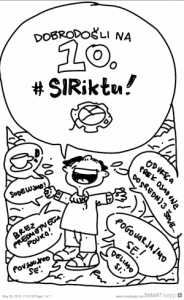Bojan Kašuba, OŠ Mislinja
Goals motivate us to distinguish between our current state and what we want to achieve. It is the role of the teacher to help learners achieve realistic goals. Teachers and learners monitor, reach and assess learners’ goals together. When goals are achieved, it is a celebration for both teachers and learners alike. Learning-to-learn is one of the most fundamental skills learners should acquire for successful independent/self-reliant learning. This skill encompasses the ability to learn, to keep up with learning and to organize learning with the help of various digital learning resources and available apps. During the History lesson, students used Microsoft Sway to learn, revise and present their views on the Holocaust. The software programme Microsoft Sway enables learners to create interactive reports and presentations, which can be published on the Internet or saved locally on a computer. Several learners can work on a single presentation simultaneously. Learners perform different roles; some learners are responsible for the visual part of the presentation, while others provide content. The main purpose of working with Microsoft Sway is to engage learners to become active co-creators of knowledge and content, while teachers only monitor and moderate. We have applied modern methods of classroom management as used in primary schools, the goal of which is to prepare learners to become independent/self-reliant individuals who are creative, critical and learn by exploring and researching. During the History lesson, the so-called “assessment sandwich” was used as part of formative assessment, whose main purpose is to provide feedback to learners about their work and results as well as to allow learners to contemplate about their own learning, behaviour, their ability to actualize and to empathize with others. The feedback was provided by us, the teachers, as well as their peers and, finally, by themselves. Feedback was based on the following questions: • What have I learnt? / What am I proud of? • What did I already know? / What am I proud of? • What could I do improve? Some information was completely new to a few learners, while others only strengthened their knowledge. The individuality of each learner was assured. The goal of developing higher thought processes and understanding was assured by raising the difficulty of tasks, individual teaching methods and learner collaboration. Finally, collaborative learning, evaluation as well as self-evaluation were also developed.
